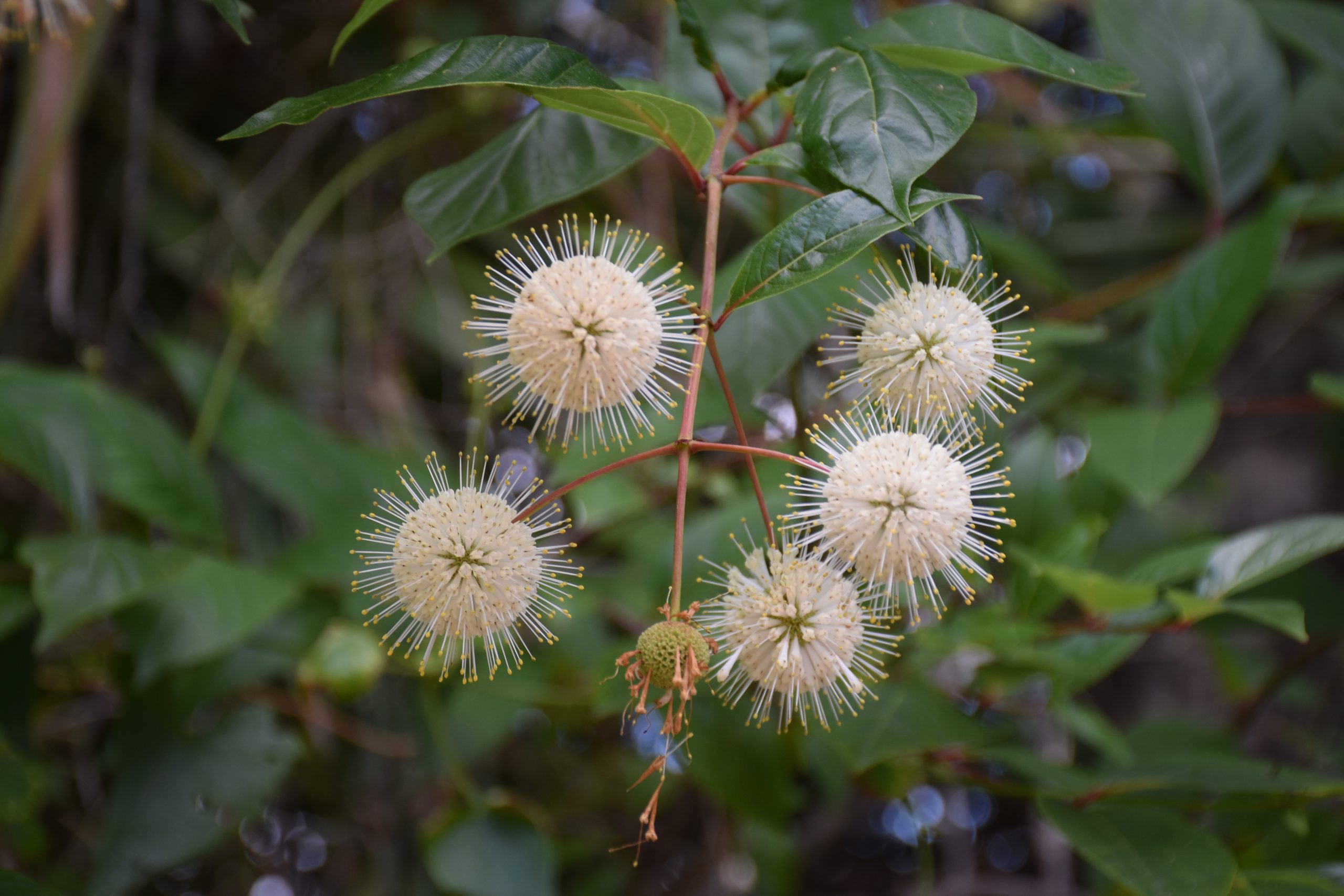Buttonbush is an attention-getting plant for wet areas that occurs across large geographic regions. It ranges as far north as Ontario, Canada, and south to Florida, with disjointed populations in Texas, Arizona, and Central California. It is also found in Cuba and Central America
Ecology and Plant Type
Buttonbush is a common woody perennial of swamps, mangroves, ponds, floodplains, and drainage ditches. A shrub, or rarely a small tree, it usually grows no more than 10 to 20 ft. tall and 6 to 12 ft. wide. Several stems emerge from the ground forming an irregular-rounded shrub. Trees are sparsely branched because of strong apical dominance. Stem color varies from grayish brown to shiny olive. Older branches are gray/silver. The bark is smooth when young, becoming ridged and furrowed as it ages, often with vertical, raised, corky lenticels.


Leaves
The dark green, glossy upper leaf surface is highly ornamental. The undersides are dull, smooth, and hairless. The leaves are arranged in opposite pairs or whorled in groups of three or four, all within a given plant. They are simple, entire, petiolate, varying in size from 2 to 8 in. long and 2 to 3.5 in. wide. They are ovate, or elliptic and less commonly oblong shaped with a pointed apex. The blades have a yellow midrib and prominent, depressed veins.


Flowers
The white pincushion like flowers is the buttonbush’s main attraction. In South Florida, flowering begins as early as March and continues into August. Peak bloom is in May when camouflaged plants become highly visible. The unusual inflorescences hang downwards on long green peducles at the end of the current season’s growth. They consist of innumerable florets tightly packed in a 1 to 1.5 in. sphere. The florets are sessile, bisexual, white fused tubular corolla, about 0.4 in. long, with protruding styles. They are attached to a green globose cluster of calyces. The flowers have a subtle fragrance and attract ants, bees, butterflies, and hummingbirds.


Fruit
The fruit is an aggregate of many tiny fruitlets forming a 1 in. compact woody ball. They mature in winter splitting into 2 or 4 parts to reveal small seeds. The seeds are a food source for waterfowl and other birds.

Landscape Use and Maintenance Guidelines
In South Florida, buttonbush is semi-deciduous but is deciduous further north. It does best in sunny locations in moist soils. It is useful for naturalizing wet areas. If left unattended it will colonize much of the water’s edge along lakes and ponds. It may also be used along decks, patios and in native plant gardens.
Buttonbush is said to be difficult to establish on the “fill” soils of South Florida. If grown in dry situations, it requires moderate irrigation. Some diebacks may occur during moderate or extended drought, especially in the southern part of its range.
Buttonbush responds well to pruning and can be kept to a small size in the landscape. Pruning serves to produce a more densely foliated plant. The lower branches can be removed to establish a more tree-like shape. The plant is moderately long-lived to as many as 50 years. Parts of the plant, particularly the leaves, are toxic to humans and livestock.
Click here or type in fann.org/plants/ in your browser for sources of buttonwood and other Florida native plants.

Resources
Gilman, Edward F., Klein, Ryan W., and Hansen Gail. Cephalanthus occidentalis Buttonbush. Revised March 2023. UF/IFAS, University of Florida, Gainesville, Florida.
Godfrey, Robert K. and Wooten, Jean W. 1981. Aquatic and Wetland Plants of Southeastern United States Dicotyledons. University of Georgia Press, Athens.
Nelson, Gil. 2003. Florida’s Best Native Landscape Plants: 200 readily available species for homeowners and professionals. University Press of Florida, Gainesville, Florida.
Ossorio, Rufino. 2001. A Gardeners Guide to Florida Native Plants. University of Florida Press, Gainesville, Florida.
 2
2
